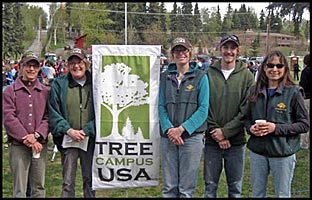
Tree City USA
Tree City USA is a national program that recognizes cities with effective, ongoing community forestry programs. Cities of any population, from less than 100 to several million, can qualify. Tree City USA is sponsored by the National Arbor Day Foundation and the National Association of State Foresters. For more information and an application, see www.arborday.org.
To qualify, a city must meet four standards:
- A board, commission, or department charged by ordinance to develop and administer a comprehensive city tree management program. These are often volunteer groups in small towns.
- A tree ordinance that designates a board, commission, or department and gives them responsibility for writing and implementing an annual community forestry work plan. The ordinance sets tree care policies for planting, maintenance, and removals.
- A community forestry budget of at least $2 per capita. This includes all funds spent on tree care.
- An Arbor Day observance and proclamation. In Alaska, Arbor Day is the third Monday in May.
In Alaska, Anchorage, Eielson Air Force Base, Fort Wainwright, Joint Base Elmendorf-Richardson, Juneau, Ketchikan Gateway Borough, Sitka, and Wasilla are Tree Cities USA.

Chugach Electric helps students plant Arbor Day trees.
Matanuska Electric Arboretum in Palmer - right tree in the right place.
Golden Valley Electric gives away seedlings to customers on Arbor Day.
Tree Line USA
Tree Line USA recognizes utilities that follow practices that protect and enhance urban forests. Tree City USA is sponsored by the National Arbor Day Foundation and the National Association of State Foresters. For more information and an application, see www.arborday.org.
Requirements for recognition are:
- Quality Tree Care — The utility follows industry standards for pruning, planting, removals, and trenching and tunneling near trees.
- Annual Worker training — The utility ensures that its employees and contract workers are trained in best practices.
- Tree Planting and Public Education — The utility sponsors and participates in a tree planting and public education program designed to expand canopy and educate customers about the proper tree planting, placement, and pruning.
- Tree-based Energy Conservation Program — The utility has a formal tree-based energy conservation program which makes special consideration of the value of trees in conserving energy.
- Arbor Day Celebration — The utility sponsors and/or participates in annual Arbor Day events, and collaborates with community groups, where possible.
The Tree Lines USA in Alaska are Chugach Electric Association, Golden Valley Electric Association, and Matanuska Electric Association.

Tree Campus USA
The Tree Campus USA program, just begun in 2008, recognizes college and university campuses that:
- Effectively manage their campus trees.
- Develop connectivity with the community beyond campus borders to foster healthy, urban forests.
- Strive to engage their student population utilizing service learning opportunities centered on campus, and community forestry efforts.
Colleges and universities across the United States can be recognized as a Tree Campus USA college by meeting five standards developed to promote healthy trees and student involvement.
- Campus Tree Advisory Committee
- Campus Tree Care Plan
- Campus Tree Program with Dedicated Annual Expenditures
- Arbor Day Observance
- Service Learning Project
The University of Alaska Anchorage has been recognized as a Tree Campus USA since 2009 and the University of Alaska Fairbanks has been recognized since 2011. For details on Tree Campus USA and an online application go to www.arborday.org.
Tree Campus K-12
The NASF grant and Project Learning Tree curriculum are also excellent opportunities for schools to become recognized by the national Arbor Day Foundation as a Tree Campus K-12. The goal of this program is to "inspire the next generation of tree stewards through experiences that bring the benefits of trees to life both outside and in the classroom." To achieve recognition, schools are required to meet four basic program goals:

Schools are encouraged to involve students in the application and planning process. Simply by completing this application process and hosting a student-led planting event, schools can reach many of the benchmarks required for recognition. For more information about becoming a Tree Campus K-12 and the many benefits associated with recognition, visit the Arbor Day Foundation Website.
